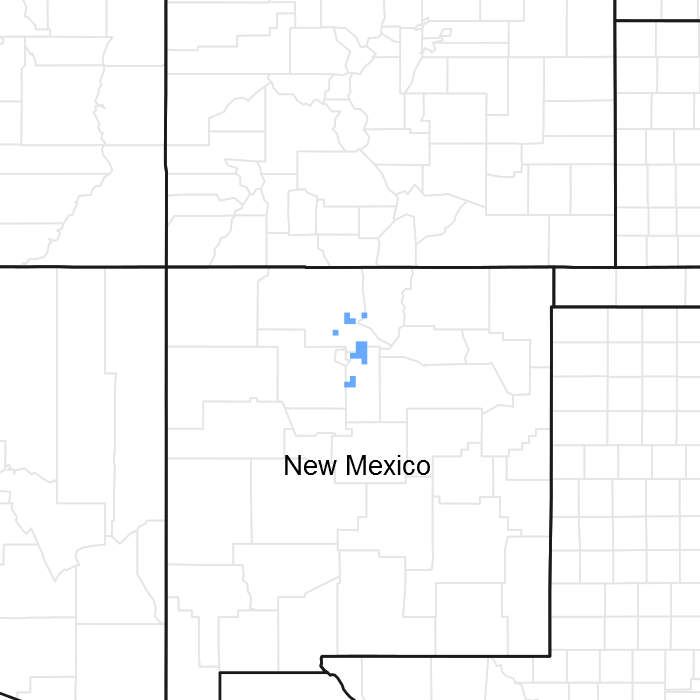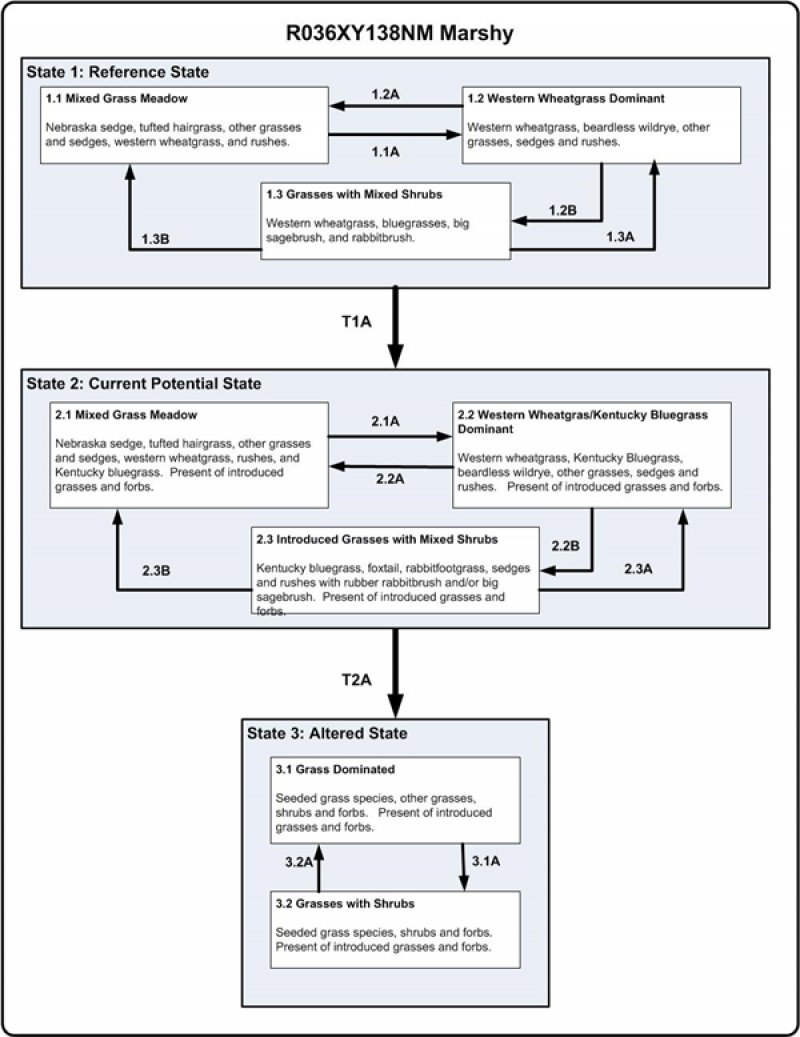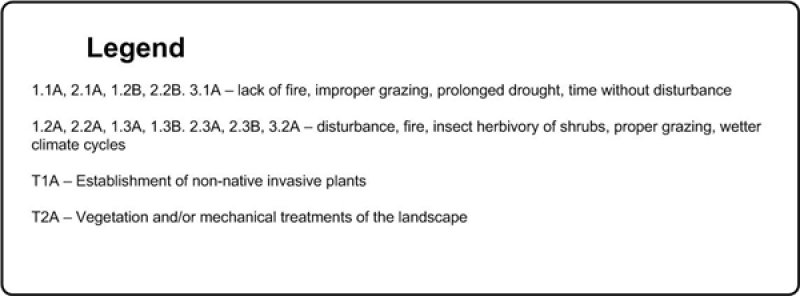Ecological dynamics
MLRA 36 occurs on the higher elevation portion of the Colorado Plateau. The Colorado Plateau is a physiographic province which exists throughout eastern Utah, western Colorado, western New Mexico and northern Arizona. It is characterized by uplifted plateaus, canyons and eroded features. The Colorado Plateau lies south of the Uintah Mountains, north of the Mogollon transition area, west of the Rocky Mountains, and east of the central Utah highlands. The higher elevation portion of the Colorado Plateau which is represented by MLRA 36 is characterize by broken topography, and lack of perennial water sources. This area has a long history of past prehistoric human use for years. MLRA 36 shows archaeological evidence indicating that pinyon-juniper woodlands where modified by prehistoric humans and not pristine and thus where altered at the time of European settlement (Cartledge & Propper, 1993). This area also included natural influences of herbivory, fire, and climate. This area rarely served as habitat for large herds of native herbivores or large frequent historic fires due to the broken topography. This site is extremely variable and plant community composition will vary with the water fluctuations on this site.
The lower part MLRA 36 developed under climatic conditions that include hot, dry summers with summer rains showers and little to no snow with the mild winter temperatures. This area has climatic fluctuations and prolonged droughts are common occurrences. Between an above average year and a drought year. Forbs are the most dynamic component of this community and can vary up to 4 fold (Passey et.al. 1982). The precipitation and climate of MLRA 36 are conducive to producing Pinyon/juniper, and sagebrush complexes with high productive sites in the bottoms of the canyons. Predominant species on the Colorado Plateau are Wyoming big sagebrush (Artemisia tridentata var. wyomingensis), mountain big sagebrush (A. tridentata var. vaseyana), and black sagebrush (A. nova), basin big sagebrush (A. tridentata var. tridentata), Utah juniper (Juniperus utahensis), one-seed juniper (Juniperus monosperma), and two-needle pinyon (Pinus edulis). One-seed juniper has the capability to discontinue active growth when moisture is limited but can resume growth when moisture availability improves. This growth pattern may represent an important adaptation allowing them to survive on very arid sites. It is possible that small trees may be killed by drought; mature one-seed junipers are resilient to drought, especially in comparison to two-needle pinyon (Johnsen, 1962).
The productivity and composition of this plant community would have been quite stable, although varying with the climate because it would have been affected by runoff from streams originating at higher elevations in adjacent mountains. The water table usually persisted throughout the year, causing poorly-aerated soils. The water table is fed by spring snow melt, groundwater and monsoonal rains. Following very wet winters, the melting snow pack would have caused a high and widespread surge of flooding. Wet meadows are areas where it floods frequently or has a shallow water table with some wetland properties. Wet Meadows are a small portion of the landscape footprint. Less than 1% of the landscape in the southwest are characterized as wetlands and wet meadows is just one of several wetland types that occur (Ramstead, 2012). This site is important part of the landscape as it often serves as habitat for plants, birds and other wildlife.
Wet meadows in the southwest are one of the most altered ecosystem types by humans. They are used for livestock and wildlife grazing, many locations have small dams with ponds or stock tanks. In irrigated meadows, roads are commonly built through or adjacent to them, they are prone to invasive species and can be impacted by wildfires in the surrounding upland areas. (Ramstead et al., 2012)
Meadows with tufted hairgrass as a major component are very sensitive to water table fluctuations. A study in Oregon showed that when the water table is lowered it favored increases in Kentucky bluegrass and perennial forbs in the species composition. While increase in the water table favored sedges and rush establishment. (Walsh, 1995) In the mountain west, Kentucky bluegrass is well adapted to the meadow with seasonally high water tables and midsummer drought. Kentucky bluegrass has become dominated on many meadows which once had a larger component of tufted hairgrass. (Uchytil, 1993)
Records of fire with wet meadows are lower elevations are rare to non-existent. The communities listed do not include wet meadows for fire regimes. In general, Intermountain riparian communities have been found to have a fire interval of 20 to 370 years (USDA, 2012a). While southwestern desert grasslands have a fire interval of 10-833 years (USDA, 2012b). Another source states that meadows have a fire return interval of 30 to 60 years (Landfire, 2007). The second source covers 2 ecological sites. It covers the upper precipitation end of wet meadow, and mountain meadows ecological site from an adjacent MLRA (48A). This site is not described in the fire regime literature that is available at this time. The data available is for general vegetation types in the United States: no specific data for wet meadows on Colorado Plateau is available at this time.
Variability in climate, soils, aspect and complex biological processes will cause the plant communities to differ. These factors contributing to annual production variability include wildlife use, drought, and insects. Factors contributing to special variability include soil texture, depth, rock fragments, slope, aspect, and micro-topography. The species lists are representative and not a complete list of all occurring or potentially occurring species on this site. The species lists are not intended to cover the full range of conditions, species and responses of the site. The State & Transition model depicted for this site is based on available research, field observations and interpretations by experts and could change as knowledge increases. As more data is collected, some of these plant communities may be revised or removed, and new ones may be added. The following diagram does not necessarily depict all the transitions and states that this site may exhibit, but it does show some of the most common plant communities.
State 1
Reference
On soils having a mesic soil temperature regime, Baltic rush and Nebraska sedge are subordinate to Western Wheatgrass and are aggregated in colonies only in wetter depressions. Orange arnica, silverweed and small bedstraw are typical forbs of more mesic sites. On the drier precipitation range of this site Nevada bluegrass, Beardless wildrye (creeping wildrye), western yarrow and rose pussytoes are subordinate to tufted hairgrass. If the condition of this site deteriorates as a result of overgrazing, Western wheatgrass decreases and becomes co-dominant with other grasses, sedges and forbs. Baltic rush, sedges or reedgrass become more dominant, with large colonies of arnica, and silverweed occurring on the more mesic sites.
With overgrazing on soils having a mesic soil temperature regime, Nebraska sedge is capable of becoming dominant. On the drier precipitation range of this site, prairie junegrass and oatgrass along with yarrow, aster, cinquefoil and buttercups increase. With lowering of the water table Kentucky bluegrass can become naturalized and become co-dominant with mat muhly. Severe stream entrenchment may change the stand composition to upland species such as big sagebrush, grey rabbitbrush and annual weeds. Foxtail barley, squirreltail, lupine, dock and thistle are likely to invade.
This site is used for livestock grazing and wildlife habitat. The historic climax vegetation is rush, sedge, western wheatgrass, bluejoint. Dynamics of the site revolve around available moisture and drainage and deposits of alluvial material and scouring when the intermittent stream moves the channel. These events add or subtract soil and nutrients from the site. They also change the hydrology either adding water, ponding longer or the site drys out resulting in species shifts. The shallow water almost year round makes this a highly productive and resilient site. Most of the communities in this site are in the reference state. A major long term shift in hydrology is needed to change states.
Community 1.1
Mixed Grass Meadow
This community phase vegetation is dominantly rush, sedge, western wheatgrass, and bluejoint. Dynamics of the site revolve around available moisture and drainage and deposits of alluvial material and scouring when the intermittent stream moves the channel. These events add or subtract soil and nutrients from the site. They also change the hydrology either adding water, ponding longer or the site drys out resulting in species shifts. The shallow water almost year round makes this a highly productive and resilient site.
Table 5. Annual production by plant type
| Plant type |
Low
(lb/acre) |
Representative value
(lb/acre) |
High
(lb/acre) |
| Grass/Grasslike |
900 |
1200 |
1500 |
| Forb |
100 |
200 |
300 |
| Total |
1000 |
1400 |
1800 |
| Jan |
Feb |
Mar |
Apr |
May |
Jun |
Jul |
Aug |
Sep |
Oct |
Nov |
Dec |
| J |
F |
M |
A |
M |
J |
J |
A |
S |
O |
N |
D |
Community 1.2
Western Wheatgrass Dominant
This plant community is a result of time without disturbance, mainly from fire, and prolonged drought. As this site deteriorates due to improper grazing tufted hairgrass, oatgrasses, slender wheatgrass and forbs decrease while Kentucky bluegrass, western wheatgrass, rushes, rubber rabbitbrush, and yellow rabbitbrush increase. Foxtail barley, povertyweed, and cheatgrass are most likely to invade this site.
| Jan |
Feb |
Mar |
Apr |
May |
Jun |
Jul |
Aug |
Sep |
Oct |
Nov |
Dec |
| J |
F |
M |
A |
M |
J |
J |
A |
S |
O |
N |
D |
Community 1.3
Grass and Mixed Shrub
Upland shrubs will increase on this site as it gets drier. Rubber rabbitbrush and big sagebrush may increase, if present near the site. Foxtail may replace wetter species if the grazing pressure is great and there has been a prolonged drought.
| Jan |
Feb |
Mar |
Apr |
May |
Jun |
Jul |
Aug |
Sep |
Oct |
Nov |
Dec |
| J |
F |
M |
A |
M |
J |
J |
A |
S |
O |
N |
D |
Pathway 1.2A
Community 1.2 to 1.1
This pathway is caused by naturally occurring fires and/or insect herbivory removes the shrubs. It reverts the system back to a grassland phase. Proper grazing practices which allow for recover of tufted hairgrass, Nebraska sedge, and other grass species will also help this pathway. Also, wetter climatic cycles will help to decrease shrubs as the shrubs that would occur here naturally don’t like to be in areas of standing water for extended periods of time.
Pathway 1.2B
Community 1.2 to 1.3
This pathway happens when fire does not occur within the historical fire regime interval for the site. Improper continuous grazing of perennial grasses will speed up this pathway. Improper grazing will cause, foxtail, and rubber rabbitbrush to increase. Also, prolonged drought with decreased water tables will progress along this pathway.
Pathway 1.3B
Community 1.3 to 1.1
This pathway is caused by naturally occurring fires and/or insect herbivory removes the shrubs and possible trees if they have encroached on this site. It reverts the system back to a grassland phase. These events tend to favor grass establishment. Also, brush management and proper grazing can benefit this pathway.
State 2
Current Potential
The current potential state is similar in structure and function to the reference state, however invasive and non-natives species are present in all community phases. The current potential state is generally dominated by perennial grasses. Kentucky bluegrass can become a dominant in this plant community. The current potential state is less resilient than the reference state due to the presence of non-native/invasive species in the plant community. Annual herbaceous weedy plants have increased, but occur in small patches. Invasive species present can include knapweeds, Canada thistle, and curly dock.
Community 2.1
Mixed Grass Meadow
This plant community is comprised of tufted hairgrass, sedges, and rushes with few scattered rubber rabbitbrush. Kentucky bluegrass may be found in this phase. Abundance, and production of herbaceous plants and forb production are dependent on the timing of precipitation, and can vary widely between years. Nonnative invasive species, such as thistles, knotweeds, dandelion, and povertyweed are present but in insignificant amounts.
| Jan |
Feb |
Mar |
Apr |
May |
Jun |
Jul |
Aug |
Sep |
Oct |
Nov |
Dec |
| J |
F |
M |
A |
M |
J |
J |
A |
S |
O |
N |
D |
Community 2.2
Western Wheatgrass and Kentucky Bluegrass Dominant
This plant community is a result of time without disturbance, mainly from fire and prolonged drought. Western wheatgrass and rubber rabbitbrush will have increased in abundance. Nonnative invasive species, such as thistles, knotweeds, dandelion, and povertyweed are present but in insignificant amounts.
| Jan |
Feb |
Mar |
Apr |
May |
Jun |
Jul |
Aug |
Sep |
Oct |
Nov |
Dec |
| J |
F |
M |
A |
M |
J |
J |
A |
S |
O |
N |
D |
Community 2.3
Introduced Grasses with Mixed Shrubs
Foxtail and Baltic rush dominates the plant community. Also, rubber rabbitbrush has increased. Foxtail may replace the other perennial if the grazing pressure is great and there has been a prolonged drought. Nonnative invasive species, such as thistles, knotweeds, dandelion, and povertyweed are present but in insignificant amounts.
| Jan |
Feb |
Mar |
Apr |
May |
Jun |
Jul |
Aug |
Sep |
Oct |
Nov |
Dec |
| J |
F |
M |
A |
M |
J |
J |
A |
S |
O |
N |
D |
Pathway 2.2B
Community 2.2 to 2.1
This pathway happens when fire does not occur within the historical fire regime interval for the site. Improper continuous grazing of perennial grasses will speed up this pathway. Improper grazing will cause, foxtail, and rubber rabbitbrush to increase. Also, prolonged drought with decreased water tables will progress along this pathway.
State 3
Altered
This state results from seeding introduced perennial grasses. Some of the potential grass found may include the following: meadow foxtail, orchardgrass, meadow barley, timothy and smooth brome. Native perennial grasses, forbs and shrubs may be included in the seed mix. This state behave similar community dynamics to the current potential state community. Other vegetation treatments may be necessary to get to this state, they include mowing, disking, prescribed burning and other techniques which manipulate the plant community. The seeded state could persist for long periods of time with proper management. Native grasses and forbs may reestablish over time from nearby seed sources.
Community 3.1
Grass Dominated
This community is dominated by seeded plants. Shrubs has little to no production in this phase. This site has high production due to the seed grass production. This production typically is higher than the current potential or reference state. This site usually has low species diversity.
| Jan |
Feb |
Mar |
Apr |
May |
Jun |
Jul |
Aug |
Sep |
Oct |
Nov |
Dec |
| J |
F |
M |
A |
M |
J |
J |
A |
S |
O |
N |
D |
Community 3.2
Grass and Shrub
This community consists shrubs with grasses. Nonnative invasive species, such as thistles, knotweeds, dandelion, and povertyweed are present but in insignificant amounts.
| Jan |
Feb |
Mar |
Apr |
May |
Jun |
Jul |
Aug |
Sep |
Oct |
Nov |
Dec |
| J |
F |
M |
A |
M |
J |
J |
A |
S |
O |
N |
D |
Transition T2A
State 2 to 3
This transition is triggered by management decisions and actions. This transition, to a state that has been seeded with introduced perennial grasses. High energy inputs are needed for this transition. Brush will need to be removed with vegetation treatment techniques (I.e. chemical, mechanical, or fire) and introduced species that are adapted to the area and adapted to management needs have been seeded and become established. Water diversion maybe used to enhance or alter this site hydrological regime.



